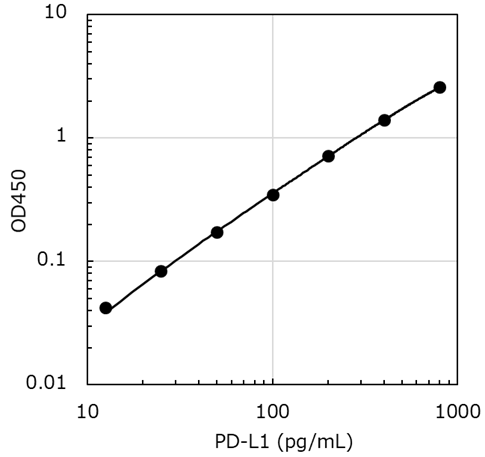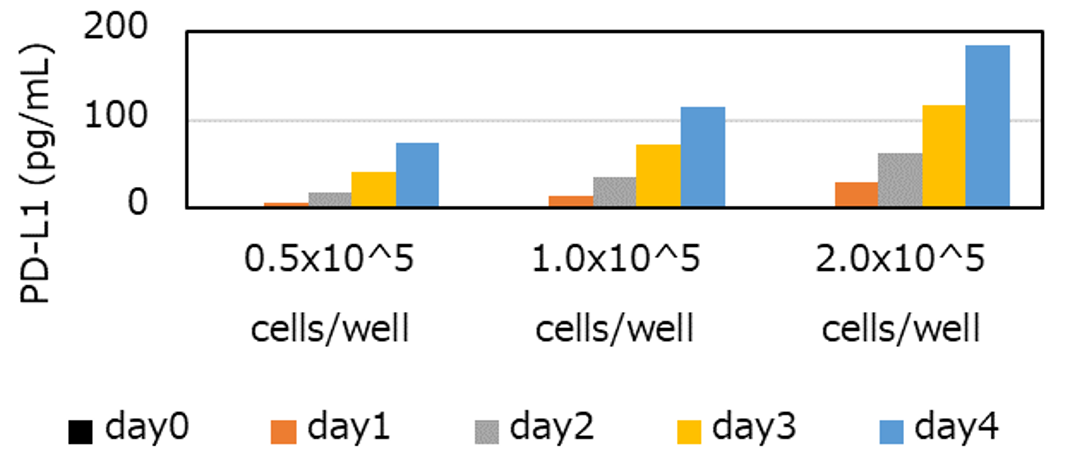Product Description
This kit uses a one-step sandwich assay with a high-performance antibody against PD-L1, an immune checkpoint-related molecule, to quantify human PD-L1 in samples with high sensitivity.
Background
What is PD-L1?
Cancer cells express PD-L1 (programmed cell death ligand-1) on their surface, which is a receptor for the PD-1 receptor expressed on the surface of activated T cells, and suppress T cell activity through PD-1/PD-L1 binding, thereby evading immune surveillance1 ), 2) . In recent years, these immune surveillance mechanisms have been applied to cancer treatment, and anti-PD-1 and anti-PD-L1 antibodies have been developed to enhance T cell activation by inhibiting this binding, and their clinical efficacy and safety have been confirmed in various solid cancers3 ), 4) . However, although resistance to treatment after the initial effect has been observed in many cases, the mechanism of resistance to anti-PD-L1 antibodies remains largely unknown.
Recently, two unique secreted PD-L1 splicing variants lacking the transmembrane domain have been identified in patients with anti-PD-L1-resistant NSCLC5 ) . It has been suggested that the secreted PD-L1 splicing variant induces resistance to PD-L1 inhibitors by acting as a decoy, and the levels of soluble PD-L1 in plasma (exosome-free) or pleural fluid in patients with the secreted PD-L1 splicing variant were higher than those in healthy donors or patients without the secreted PD-L1 variant.5 ) Furthermore, it has been suggested that the blood concentration of soluble PD-L1 may predict the clinicopathological characteristics, treatment response, and survival outcomes of cancer patients.6 )
Features
- Highly sensitive detection of human PD-L1 using the 1-Step ELISA method (detection sensitivity: 1 pg/mL * )
- No special equipment is required; measurements can be made with a regular plate reader.
*Calculated from the standard deviation of blank absorbance and the slope of the calibration curve7 )
Kit Components
| Contents | capacity | quantity |
|---|---|---|
| Anti-PD-L1 antibody immobilized plate | 96 well (8-well x 12 strips) | 1 sheet |
| Standard PD-L1 | 100 µL | 1pc * |
| Assay Buffer | 15 mL | 1 bottle |
| Washing buffer (10x) | 15 mL | 1 bottle |
| HRP-labeled anti-PD-L1 antibody (250×) | 20 µL | 1 bottle |
| Substrate solution | 12 mL | 1 bottle |
| Stop solution ( 2N H2SO4 ) | 6 mL | 1 bottle |
| Plate seal | - | 1 sheet |
*; n=2, calibration curve 3 times
Specification
| Cross-reactivity | Sample Type | Measurement range | sensitivity |
|---|---|---|---|
| Human | Serum, Plasma, Cell culture supernatant | 12.5–800 pg/mL | 1 pg/mL |
Example data

Figure 1. Standard curve

Figure 2. Cell culture supernatant
(Time course of PD-L1 levels in the culture supernatant of PD-L1-overexpressing HEK293 cells)
| Sample | Recovery rate (%) | |
|---|---|---|
| Average | range | |
| serum | 94% | 92% - 99% |
| plasma | 91% | 88% - 93% |
Spike recovery (serum, plasma)
| Product Specifications | |
| Reactivity | Human |
| Documents & Links for PD-L1 ELISA Kit (Human) | |
| Datasheet | PD-L1 ELISA Kit Datasheet |
| Documents & Links for PD-L1 ELISA Kit (Human) | |
| Datasheet | PD-L1 ELISA Kit Datasheet |


